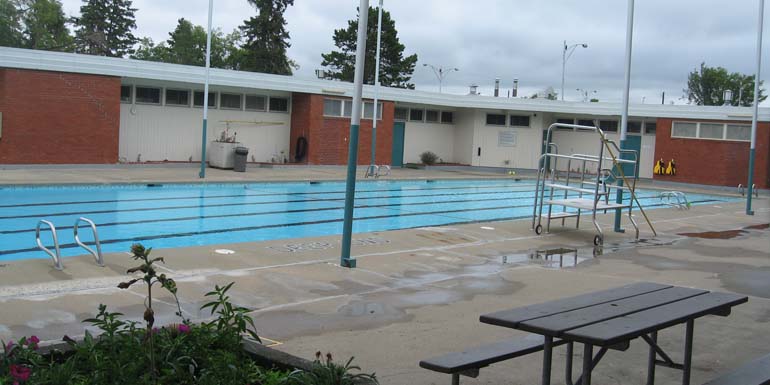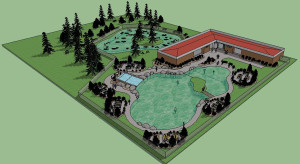Reimagining a local pool
by Sally Bouorm | October 1, 2011 2:23 pm
 [1]
[1]By Kara E. Smith
Edmonton’s Borden Park outdoor swimming pool retains the same five-lane rectangular tank and basic character from its original construction 86 years ago. Still in use today, it is desperately in need of a 21st century update.
 [2]
[2]According to the Borden Park revitalization committee, “The concept of developing a natural swimming pond (NSP) was recommended as a viable option to the replacement of the existing outdoor pool at the end of its lifecycle,” citing the importance that it “(provide) unique, year round outdoor recreational opportunities, while honouring the history of the park.”
In essence, a NSP is a chemical-free alternative to a traditional, sterilized swimming pool that functions as a living ecosystem, while providing excellent water quality for bathers. In 2010, the city of Edmonton contracted BioNova Natural Pools (North America) to conduct a feasibility study that further explored the possibilities of constructing a NSP in Borden Park.
Design and functionality
The revitalization committee was seeking a unique swimming facility with the same level of functionality as the current pool (e.g. lap lanes and diving areas). They also wanted features such as an accessible swimming and wading area, natural areas and a waterfall.
In taking the committee’s requests into consideration, BioNova presented a couple of design possibilities in the feasibility report, which included:
- a separated swimming area and shallow end;
- islands in the swimming area and regeneration zones;
- waterslides, lounge areas and spillways around the pool’s perimeter; and
- renovation of the plumbing systems and inflow of treated water on the basin wall.
The design options presented would provide approximately 700 to 800 m2 (7,535 to 8,611 sf) of total swimming area in addition to a 400 to 600 m2 (4,305 to 6,458 sf) regeneration zone. Costs for either project would be $6 to 7 million and include all renovation costs. This is comparable to building a traditional swimming pool; however, NSPs must encompass a greater total surface area to account for the regeneration zone. The report concluded that a NSP in Borden Park would be both viable and desirable from the viewpoints of Edmonton’s Urban Parks Management Plan (UPMP), Recreation Facility Master Plan and Outdoor Aquatic Strategy.
Necessary upgrades
Any new pool structure in Borden Park would need to include several essential features, such as renovated plumbing, a modern and innovative pool design to attract patrons of various ages and backgrounds, ecological sensitivity and long-term viability.
Not only would a NSP meet these renovation requirements, it was also evident that it would integrate well with existing visions for the city’s park and recreation plans, which focused on innovative aquatic opportunities, environmental sustainability, accessibility and year-round operation.
Some of the main concerns the committee addressed to BioNova included climate compatibility, health and water quality, government regulations, design possibilities and cost. In addressing these concerns, BioNova took these variables into account in order to ascertain the feasibility of such a project in Edmonton.
Climate concerns
Climate was the first concern on the list, not in terms of system functionality, but how often people would want to go swimming in a city with a 9 C (48 F) yearly average temperature.
Given the success of Borden Park’s outdoor pool since 1925, however, it can only be presumed that Canadians are more adventurous than their southern neighbors, at least when it comes to outdoor aquatic recreation. Incidentally, the first NSPs were constructed in the mountainous Austrian Alps, with cold weather climates similar to Edmonton. This made it easy to acquire appropriate references to public pools with comparable freeze/thaw cycles, average temperatures, precipitation levels and daylight hours.
By studying two popular and thriving NSPs in climates similar to Edmonton, (e.g. Maria Einsiedel in Munich, Germany and Naturerlebnisbad Sigtuna in Sigtuna, Sweden), it was concluded that climate conditions would not be an issue. Although winter temperatures in Edmonton are slightly colder than the two cities cited above, it would not carry any significant influence on a NSP’s microbiological functions. It is perfectly fine for a NSP to freeze, and once it is frozen it does not matter how much colder it gets.
Water quality concerns
The biggest concern about a public NSP is usually related to health and water quality, as it can go against modern sensibilities to equate sanitation with anything besides sterilization.
How can proper sanitation be ensured in a pool that does not use chemicals to treat the water? In the case of chemically treated pools, all bacteria are eliminated from the water. However, there are other methods to achieve high water quality besides sterilization. A NSP fosters the growth of what are considered ‘good bacteria,’ which are essential to a healthy, natural ecosystem.
Fortunately for North Americans, the history of European NSP construction and usage, which dates back more than 25 years, has provided excellent water quality records and research into natural water purification methodology.
 [3]
[3]The first NSPs originated in Austria in the early 1980s. They were fairly simple and incorporated few of the technological innovations used today. However, the pioneers of these natural ponds understood the biological principles behind water purification and used this knowledge to mimic and recreate natural processes in their own designs. By the late ‘80s the market for residential NSPs spread and soon led the way for public NSPs, with the first constructed in Herzogsdorf, Austria in 1990. This public NSP is still in use today and has been joined by more than 100 additional public NSP installations in Germany alone.
In such pools, patrons can number in the thousands during the height of summer. During this period, recorded data, which includes rigorous testing on bacterial indicators such as E. coli, Enterococci and Pseudomona, has consistently shown harmful bacteria levels well below stringent German standards.1 This proves the viability of the NSP concept and technology to create a safe swimming environment, even in a public setting.
Health and safety regulations pose a challenge
Despite this record, fitting NSPs into the framework of local governmental health and safety regulations could pose a challenge in Canada and the United States. Europe already has set standards and best-practice models in place, but North America has nothing quite like a public NSP at this point in time. To fall under existing codes, it might be helpful to regard a public NSP as similar to a public beach, which is perhaps their closest cousin in current regulations.
It is quite feasible that a public NSP at Borden Park could be considered using the same codes that apply to public beaches under Alberta regulation 243/2003, Nuisance and General Sanitation Regulation. This regulation sets the minimum water quality standards for operation of a beach or constructed beach (e.g. Summerside Lake, a constructed beach near Edmonton, follows these regulations).
Though NSPs function in place of traditional pools, it is important to remember these systems are, in actuality, ponds that function as natural ecosystems. As such, they are more correlated to beaches and other natural bodies of water that are used as public swimming areas deemed safe by local governing and health authorities.
The difference lies, however, in the NSP’s design and construction, which optimizes its cleaning potential and water quality by combining natural processes with scientific knowledge and technology. If they were compared in this manner, it would be easy to make the case for NSPs, as they are held at (and easily meet) higher water quality standards than those of public beach codes in North America.
The workings of a natural swimming pond
Rather than using chemicals for sanitization, water in a NSP is purified naturally as it moves through filters, and by the biological functioning of plants and micro-organisms. The most modern and effective construction method consists of two separate bodies of water—a swimming zone and a regeneration zone—which co-operate to create a living ecosystem that keeps the water clean.
The regeneration zone is characterized by plants rooted in gravel substrate, which is a key ingredient in the water purification process. First, water exits the swimming area through skimmers, similar to a swimming pool, then flows into biological fine-filters, which collect larger debris and particulate matter. The water continues to flow, via gravity, into the regeneration zone where it passes through layers of gravel substrate. Finally, a circulation pump draws water out of the regeneration zone and returns it to the swimming zone.
The concept of the regeneration zone is essentially what allows a NSP to function. In this zone, biological principles are at work breaking down undesirable components in the water, transforming them into nutrients for plants.
Water flow is naturally an important component of the biological system and has an important role in the pool’s ecological sustainability. Water circulation rates of a NSP are much slower than those of a traditional swimming pool, resulting in greatly decreased energy consumption.
It is also important to note that soil of any sort is absent from this system. This forces plants and microbes to get all required nutrients from the water. In fact, they are competing for the same nutrients that would otherwise feed algae growth. As a result, this makes the NSP a balanced ecosystem where all plants, micro-organisms and introduced nutrients are interrelated.
NSPs function optimally when all biological factors are present in the correct ratios. The stability of the system increases over time.
A model for future North American projects
While there are more than two decades of experience in public NSP design, construction and operation in Europe, a project of this kind in Edmonton would mark the first in North America. Despite this, there are no foreseeable roadblocks from a climatological, technical or health and safety standpoint. The possibility of a public NSP presents a unique opportunity for Edmonton, and Borden Park would be an optimal setting, given that the city can come up with the means and public support for construction.
Currently, city administration is working with Alberta Health Services to establish water quality standards that would make a NSP viable. The city has also submitted the project profile into the capital budget process to secure funds and identify it as a priority in the capital plan. Should the project receive approval for further design and construction, it could become a model for future public NSPs throughout Canada and the United States.
 Kara E. Smith joined BioNova® in 2010 after graduating from Cornell University with a degree in landscape architecture. She is involved in all marketing and technical aspects of the business, from hosting webinars to writing technical presentations on natural swimming pools (NSPs). She can be reached via e-mail at kara@bionovanaturalpools.com[4].
Kara E. Smith joined BioNova® in 2010 after graduating from Cornell University with a degree in landscape architecture. She is involved in all marketing and technical aspects of the business, from hosting webinars to writing technical presentations on natural swimming pools (NSPs). She can be reached via e-mail at kara@bionovanaturalpools.com[4].
- [Image]: http://poolspamarketing.com/wp-content/uploads/2011/10/Borden-Park-Pool.jpg
- [Image]: http://www.poolspas.ca/wp-content/uploads/2015/06/Edmonton-1.jpg
- [Image]: http://www.poolspas.ca/wp-content/uploads/2015/06/Bad-Abbach-2.jpg
- kara@bionovanaturalpools.com: mailto:kara@bionovanaturalpools.com
Source URL: https://www.poolspamarketing.com/trade/reimagining-a-local-pool/